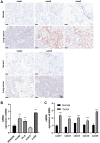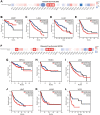A comprehensive investigation on the receptor BSG expression reveals the potential risk of healthy individuals and cancer patients to 2019-nCoV infection
- PMID: 38484369
- PMCID: PMC11006473
- DOI: 10.18632/aging.205655
A comprehensive investigation on the receptor BSG expression reveals the potential risk of healthy individuals and cancer patients to 2019-nCoV infection
Abstract
Background: Coronavirus disease-2019 (COVID-19) pandemic is caused by severe acute respiratory syndrome coronavirus 2 (SARS-CoV-2), a newly emerging coronavirus. BSG (basigin) is involved in the tumorigenesis of multiple tumors and recently emerged as a novel viral entry receptor for SARS-CoV-2. However, its expression profile in normal individuals and cancer patients are still unclear.
Methods: We performed a comprehensive analysis of the expression and distribution of BSG in normal tissues, tumor tissues, and cell lines via bioinformatics analysis and experimental verification. In addition, we investigated the expression of BSG and its isoforms in multiple malignancies and adjacent normal tissues, and explored the prognostic values across pan-cancers. Finally, we conducted function analysis for co-expressed genes with BSG.
Results: We found BSG was highly conserved in different species, and was ubiquitously expressed in almost all normal tissues and significantly increased in some types of cancer tissues. Moreover, BSG at mRNA expression level was higher than ACE2 in normal lung tissues, and lung cancer tissues. High expression of BSG indicated shorter overall survival (OS) in multiple tumors. The Gene Ontology (GO) and Kyoto Encyclopedia of Genes and Genomes (KEGG) pathway analyses indicated that BSG is mostly enriched in genes for mitochondria electron transport, oxidoreduction-driven active transmembrane transporter activity, mitochondrial inner membrane, oxidative phosphorylation, and genes involving COVID-19.
Conclusions: Our present work emphasized the value of targeting BSG in the treatment of COVID-19 and cancer, and also provided several novel insights for understanding the SARS-CoV-2 pandemic.
Keywords: BSG; COVID-19; SARS-CoV-2; cancer; susceptibility.
Conflict of interest statement
Figures










Similar articles
-
Integrated Bioinformatic Analysis of SARS-CoV-2 Infection Related Genes ACE2, BSG and TMPRSS2 in Aerodigestive Cancers.J Inflamm Res. 2021 Mar 10;14:791-802. doi: 10.2147/JIR.S300127. eCollection 2021. J Inflamm Res. 2021. PMID: 33732005 Free PMC article.
-
Pan-Cancer Analysis, Reveals COVID-19-Related BSG as a Novel Marker for Treatment and Identification of Multiple Human Cancers.Front Cell Dev Biol. 2022 May 13;10:876180. doi: 10.3389/fcell.2022.876180. eCollection 2022. Front Cell Dev Biol. 2022. PMID: 35646943 Free PMC article.
-
Distribution of ACE2, CD147, CD26, and other SARS-CoV-2 associated molecules in tissues and immune cells in health and in asthma, COPD, obesity, hypertension, and COVID-19 risk factors.Allergy. 2020 Nov;75(11):2829-2845. doi: 10.1111/all.14429. Epub 2020 Aug 24. Allergy. 2020. PMID: 32496587 Free PMC article.
-
Angiotensin-Converting Enzyme 2 (ACE2) in the Pathogenesis of ARDS in COVID-19.Front Immunol. 2021 Dec 22;12:732690. doi: 10.3389/fimmu.2021.732690. eCollection 2021. Front Immunol. 2021. PMID: 35003058 Free PMC article. Review.
-
The expression of hACE2 receptor protein and its involvement in SARS-CoV-2 entry, pathogenesis, and its application as potential therapeutic target.Tumour Biol. 2021;43(1):177-196. doi: 10.3233/TUB-200084. Tumour Biol. 2021. PMID: 34420993 Review.
References
-
- Holshue ML, DeBolt C, Lindquist S, Lofy KH, Wiesman J, Bruce H, Spitters C, Ericson K, Wilkerson S, Tural A, Diaz G, Cohn A, Fox L, et al., and Washington State 2019-nCoV Case Investigation Team. First Case of 2019 Novel Coronavirus in the United States. N Engl J Med. 2020; 382:929–36. 10.1056/NEJMoa2001191 - DOI - PMC - PubMed
Publication types
MeSH terms
Substances
LinkOut - more resources
Full Text Sources
Medical
Molecular Biology Databases
Miscellaneous

